Passive sampling for the monitoriNg of pfas in water
Published: February 2024
Download PFD
EnviroMail_13_Europe_Passive Sampling for the Monitoring of PFAS in Water
ALS laboratories have expanded the portfolio of methods for monitoring of PFAS in aquatic environment by DGT passive samplers analysis.
Per- and polyfluoroalkyl substances (PFAS) are synthetic chemicals with strong C−F bonds. Due to their high thermal stability, hydroand oleophobic properties and high surface activity, they are widely used in industrial products. Because of their persistence, bioaccumulation potential, and long-range transport potential, PFOS, PFOA, and other PFAS are being monitored in aquatic systems to help identify contamination sources and to assess temporal trends. For these projects, the DGT (Diffusive Gradients in Thin Layers) technology can be used because it provides reliable time-weighted average concentrations that are ideal for watershed-scale monitoring and source identification purposes.
ALS laboratories have extensive and long-standing experience with PFAS analysis mainly in water and soil samples and possess a broad portfolio of methods (see EnviroMails_Europe No. 01, 02 and 10).
Passive sampling
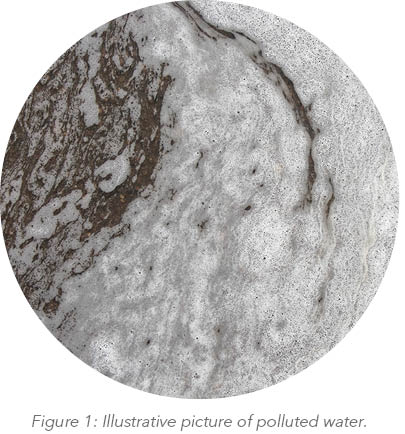
Passive sampling relies on the unassisted molecular diffusion of analytes through a diffusive surface onto an adsorbent. Unlike active (pumped) sampling, passive samplers do not require electricity, have no moving parts, and are easy to use (no pump operation or calibration). After sampling, the adsorbed analytes are desorbed from the adsorbent and quantified using a variety of analytical techniques. Passive sampling device accumulate amounts of target compounds reflecting the time weighted average concentrations over the deployment period.
Depending on the laboratory sample preparation procedure, SPOT sampling enables analysis of either total dissolved concentrations (free + colloidally bound compounds that can be passed through the filter) or total concentrations (dissolved + colloidal + particulate compounds). Contrary to spot sampling, PASSIVE sampling allows to measure only the concentration of freely dissolved compounds.
DGT Samplers
DGT samplers consist of three primary components: a hydrogel layer, a diffusive gel layer, and a filter membrane (see Figure 2). The hydrogel layer acts as a binding phase for the target analytes, while the diffusive gel layer facilitates the controlled diffusion of analytes towards the binding layer. The analytes are then immobilized in the hydrogel, enabling preservation during sample retrieval.
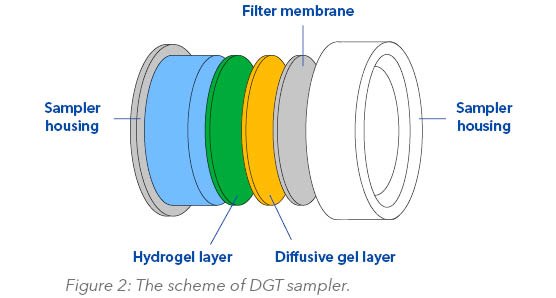
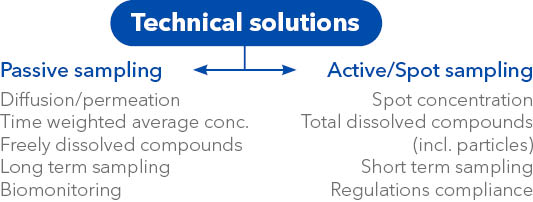
Sampling and Sample Analysis
DGT samplers are suitable for all types of water matrices (freshwater, seawater, or wastewater).
DGT samplers are deployed in flowing / moving water attached by a fishing line to a deployment device. After retrieving from the deployment environment and rinsing with ultrapure water, DGT samplers are transported to the laboratory in plastic bags with controlled moisture.
In the laboratory, the exposed samplers are removed from the bags, disassembled and the binding gel is separated from the other parts. The binding layer is extracted 24 hours fully immersed in methanol containing 0.5% NH4OH. The extract is concentrated by nitrogen, filtered, and analysed by UHPLC-MS/MS (ultra-high performance liquid chromatography coupled with tandem mass spectrometry). The identification and quantitation of target PFAS is based on internal standard calibration approach. The method is validated and involves 14 PFAS compounds for which the diffusion coefficients (D) are specified by the manufacturer (Table 2).
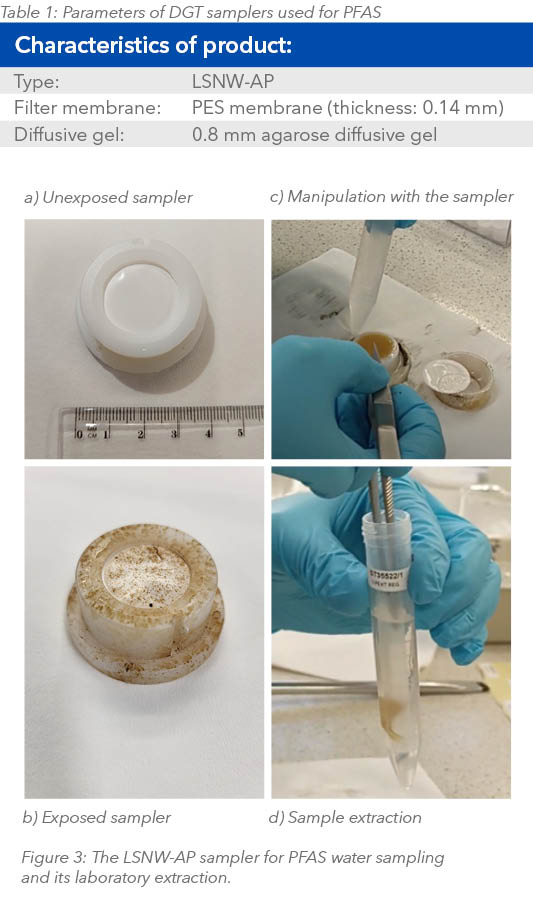
Conclusions
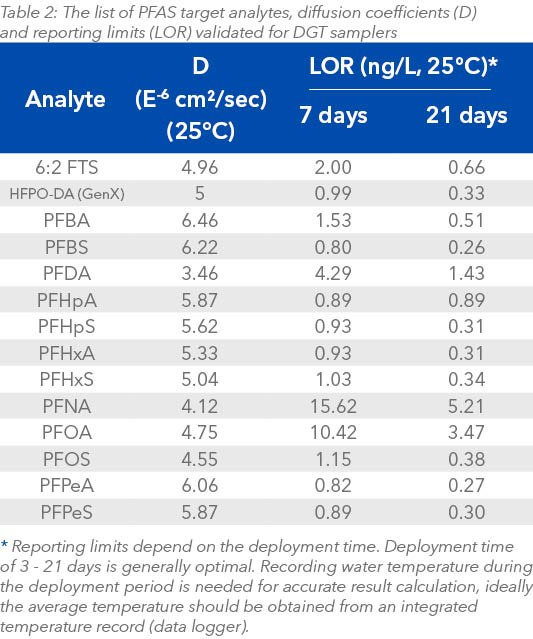
Passive sampling, particularly with DGT samplers, provides a valuable approach to understand watequality dynamics over the time. By overcoming many of the limitations of conventional spot sampling, DGT samplers contribute to a more comprehensive and accurate assessment of water quality, supporting sustainable environmental management decisions. Continued research and integration of passive sampling methods into monitoring programs will undoubtedly play a vital role in the protection of aquatic ecosystems.
Related EnviroMails:
- EnviroMail_01_Europe: PFAS Testing In Waters: The Scope of Analyses and Current State of Legislation - May 2023
- EnviroMail_02_Europe: Sampling Recommendations For PFAS to Maximize Data Quality - May 2023
- EnviroMail_10_Europe: Forever PFAS Chemicals In Soils - Nov 2023
Literature cited:
- https://www.dgtresearch.com/organic-analytes/
- Development and Applications of Novel DGT Passive Samplers for Measuring 12 Per- and Polyfluoroalkyl Substances in Natural Waters and Wastewaters; Zhou Fang, et al.; Environmental Science & Technology 2021 55 (14), 9548-9556.
- Passive Sampling in Regulatory Chemical Monitoring of Nonpolar Organic Compounds in the Aquatic Environment; Kees Booij, et al.; Environmental Science & Technology 2016, 50, 1, 3-17 (Critical Review)


